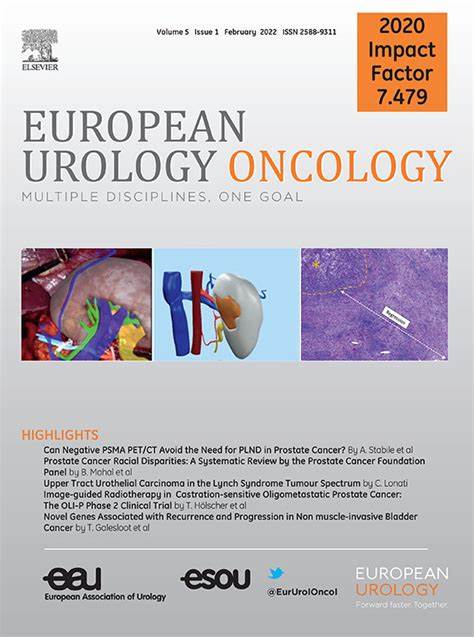A Nationwide Real-world Evaluation of Upfront Cytoreductive Nephrectomy in Patients with Synchronous Metastatic Renal Cell Carcinoma in the Immunotherapy Era
IF 8.3
1区 医学
Q1 ONCOLOGY
引用次数: 0
Abstract
Background and objective
Since the advent of targeted therapy, deferred cytoreductive nephrectomy (dCN) has been offered to patients with metastatic renal cell carcinoma (mRCC) who respond to systemic therapy. Transition to the immunotherapy (IO) era necessitates a re-evaluation of the role of upfront CN (uCN) in mRCC management. Our aim was to determine whether uCN improves overall survival (OS) in patients with mRCC receiving IO in comparison to tyrosine kinase inhibitor (TKI) therapy.
Methods
This nationwide historical cohort study included patients with synchronous mRCC diagnosed in the Netherlands between 2018 and 2020 who were treated with IO or TKI agents. We used propensity score–based inverse probability of treatment weighting (IPTW) to adjust for prognostic differences in Kaplan-Meier and Cox regression analyses. OS was compared for patients with versus without uCN. Analyses were stratified for IO and TKI therapy.
Key findings and limitations
Of 872 patients, 433 received IO (63 uCN + IO, 370 IO ± dCN) and 439 received TKI (67 uCN + TKI, 372 TKI ± dCN) therapy. The uCN treatment arms had more favourable prognostic factors than those starting with systemic therapy. In the IO cohort, the IPTW-adjusted median OS was 33 mo for uCN + IO versus 24 mo for IO ± dCN (hazard ratio [HR] 0.62, 95% confidence interval [CI] 0.40–0.97). There was no significant difference in median OS in the TKI cohort (19 mo for uCN + TKI versus 17 mo for TKI ± dCN; HR 0.76, 95% CI 0.52–1.12). Limitations include the observational nature of the study and the risk of residual confounding.
Conclusions and clinical implications
In the absence of randomised controlled trials (RCTs), our results indicate a preference for uCN in patients with mRCC with favourable prognostic factors in the IO era. Owing to the risk of residual confounding, strong evidence from RCTs is needed.
免疫治疗时代同步转移性肾癌患者的前期细胞减减性肾切除术在全国范围内的实际评估。
背景和目的:自从靶向治疗出现以来,延迟细胞减减性肾切除术(dCN)已被提供给对全身治疗有反应的转移性肾细胞癌(mRCC)患者。向免疫治疗(IO)时代的过渡需要重新评估前期CN (uCN)在mRCC治疗中的作用。我们的目的是确定与酪氨酸激酶抑制剂(TKI)治疗相比,uCN是否能提高接受IO治疗的mRCC患者的总生存率(OS)。方法:这项全国性的历史队列研究纳入了2018年至2020年期间在荷兰诊断为同步mRCC的患者,这些患者接受了IO或TKI药物治疗。我们使用基于倾向评分的治疗加权逆概率(IPTW)来调整Kaplan-Meier和Cox回归分析中的预后差异。比较有无uCN患者的OS。对IO和TKI治疗进行分层分析。主要发现和局限性:872例患者中,433例接受IO治疗(63例uCN + IO, 370例IO±dCN), 439例接受TKI治疗(67例uCN + TKI, 372例TKI±dCN)。uCN治疗组比全身性治疗组有更有利的预后因素。在IO队列中,经iptw调整的uCN + IO的中位生存期为33个月,而IO±dCN的中位生存期为24个月(风险比[HR] 0.62, 95%可信区间[CI] 0.40-0.97)。TKI组的中位生存期无显著差异(uCN + TKI组为19个月,TKI±dCN组为17个月;Hr 0.76, 95% ci 0.52-1.12)。局限性包括研究的观察性和残留混淆的风险。结论和临床意义:在缺乏随机对照试验(RCTs)的情况下,我们的研究结果表明,在IO时代,预后良好的mRCC患者更倾向于采用uCN。由于存在残留混淆的风险,需要来自随机对照试验的有力证据。
本文章由计算机程序翻译,如有差异,请以英文原文为准。
求助全文
约1分钟内获得全文
求助全文
来源期刊

European urology oncology
Multiple-
CiteScore
15.50
自引率
2.40%
发文量
128
审稿时长
20 days
期刊介绍:
Journal Name: European Urology Oncology
Affiliation: Official Journal of the European Association of Urology
Focus:
First official publication of the EAU fully devoted to the study of genitourinary malignancies
Aims to deliver high-quality research
Content:
Includes original articles, opinion piece editorials, and invited reviews
Covers clinical, basic, and translational research
Publication Frequency: Six times a year in electronic format
 求助内容:
求助内容: 应助结果提醒方式:
应助结果提醒方式:


